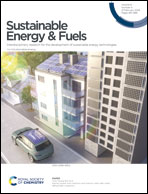Fractal growth of a fern-like nanostructured Cu2O film electrode for electrochemical reduction of CO2 to ethanol†
Abstract
Coating an electrocatalytic material on a substrate without using a binder is a preferable method to prepare electrodes for CO2 reduction. In this work, nanostructured film electrodes are prepared by electrodepositing Cu2O on the surface of a stainless steel strip (SS-316) at −0.3, −0.4 and −0.5 V for 5 minutes, which are denoted as CuP3T5, CuP4T5 and CuP5T5, respectively. The structure and various morphologies of these film electrodes and their impact on electrochemical CO2 reduction are studied. The film electrodes contain the Cu2O phase with marigold flower-like morphology (CuP3T5) and branched-3D fern-like structures (CuP4T5 and CuP5T5). Among the three nanostructured Cu2O film electrodes, the CuP4T5 film electrode shows the highest activity for CO2 reduction to ethanol, analysed by linear sweep voltammetry study and gas chromatography. The CuP3T5, CuP4T5 and CuP5T5 film electrodes show maximum faradaic efficiencies of ∼29%, ∼80% and ∼51% for the ethanol product, respectively, at the potential of −1.1 V vs. Ag/AgCl. The highest faradaic efficiency is correlated with the fractal growth morphology of the CuP4T5 sample. The mechanism of CO2 reduction to ethanol is elucidated by DFT calculations carried out on Cu2O(111).



 Please wait while we load your content...
Please wait while we load your content...